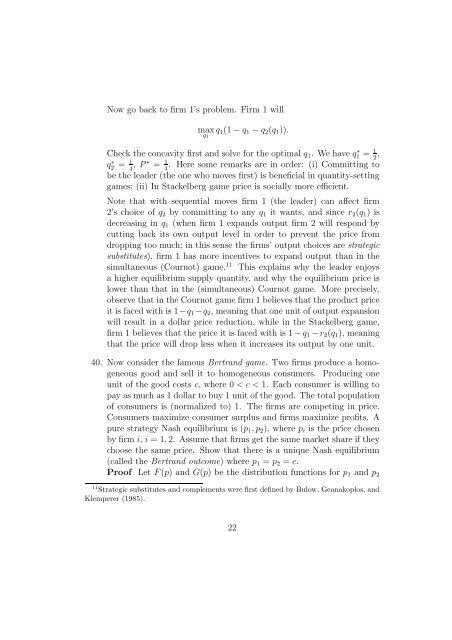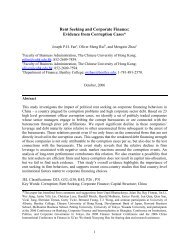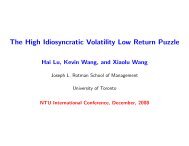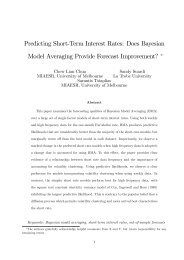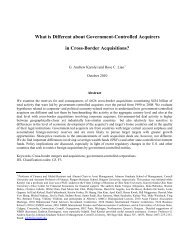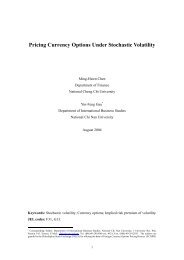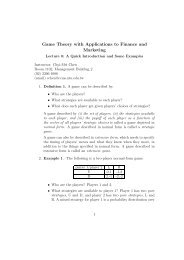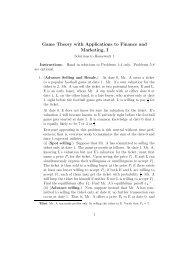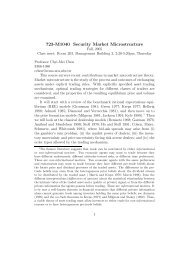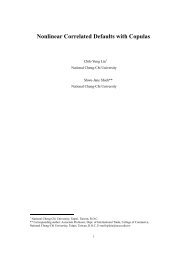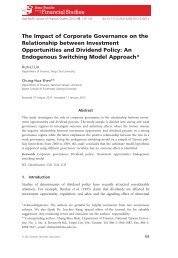Game Theory with Applications to Finance and Marketing
Game Theory with Applications to Finance and Marketing
Game Theory with Applications to Finance and Marketing
You also want an ePaper? Increase the reach of your titles
YUMPU automatically turns print PDFs into web optimized ePapers that Google loves.
Now go back <strong>to</strong> firm 1’s problem. Firm 1 willmaxq 1q 1 (1 − q 1 − q 2 (q 1 )).Check the concavity first <strong>and</strong> solve for the optimal q 1 . We have q1 ∗ = 1,2q2 ∗ = 1, P ∗ = 1 . Here some remarks are in order: (i) Committing <strong>to</strong>4 4be the leader (the one who moves first) is beneficial in quantity-settinggames; (ii) In Stackelberg game price is socially more efficient.Note that <strong>with</strong> sequential moves firm 1 (the leader) can affect firm2’s choice of q 2 by committing <strong>to</strong> any q 1 it wants, <strong>and</strong> since r 2 (q 1 ) isdecreasing in q 1 (when firm 1 exp<strong>and</strong>s output firm 2 will respond bycutting back its own output level in order <strong>to</strong> prevent the price fromdropping <strong>to</strong>o much; in this sense the firms’ output choices are strategicsubstitutes), firm 1 has more incentives <strong>to</strong> exp<strong>and</strong> output than in thesimultaneous (Cournot) game. 11 This explains why the leader enjoysa higher equilibrium supply quantity, <strong>and</strong> why the equilibrium price islower than that in the (simultaneous) Cournot game. More precisely,observe that in the Cournot game firm 1 believes that the product priceit is faced <strong>with</strong> is 1−q 1 −q 2 , meaning that one unit of output expansionwill result in a dollar price reduction, while in the Stackelberg game,firm 1 believes that the price it is faced <strong>with</strong> is 1 − q 1 − r 2 (q 1 ), meaningthat the price will drop less when it increases its output by one unit.40. Now consider the famous Bertr<strong>and</strong> game. Two firms produce a homogeneousgood <strong>and</strong> sell it <strong>to</strong> homogeneous consumers. Producing oneunit of the good costs c, where 0 < c < 1. Each consumer is willing <strong>to</strong>pay as much as 1 dollar <strong>to</strong> buy 1 unit of the good. The <strong>to</strong>tal populationof consumers is (normalized <strong>to</strong>) 1. The firms are competing in price.Consumers maximize consumer surplus <strong>and</strong> firms maximize profits. Apure strategy Nash equilibrium is (p 1 , p 2 ), where p i is the price chosenby firm i, i = 1, 2. Assume that firms get the same market share if theychoose the same price. Show that there is a unique Nash equilibrium(called the Bertr<strong>and</strong> outcome) where p 1 = p 2 = c.Proof Let F (p) <strong>and</strong> G(p) be the distribution functions for p 1 <strong>and</strong> p 211 Strategic substitutes <strong>and</strong> complements were first defined by Bulow, Geanakoplos, <strong>and</strong>Klemperer (1985).22


